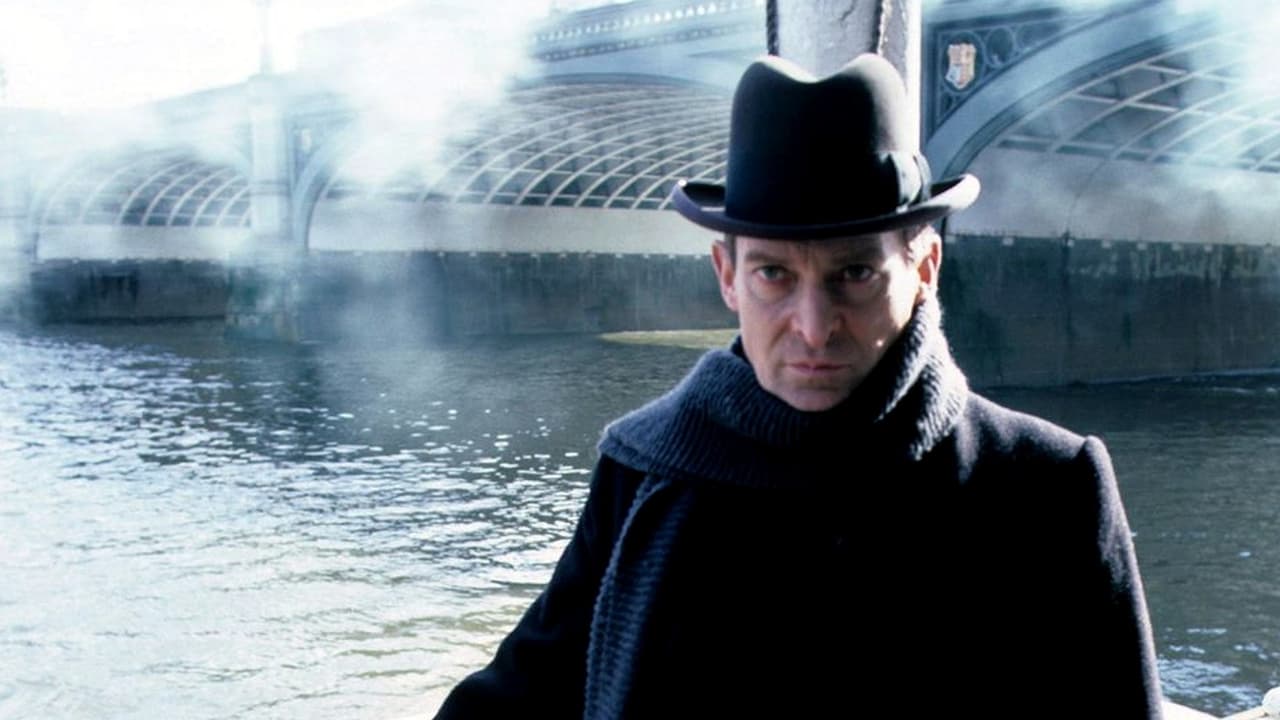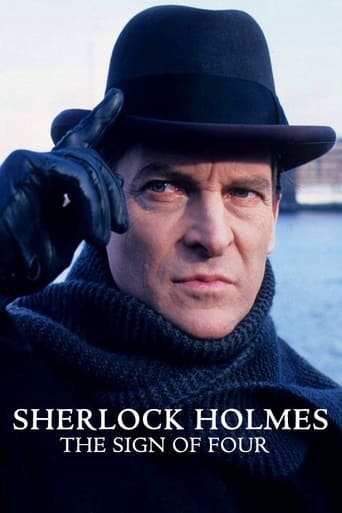



i know i wasted 90 mins of my life.
It's not great by any means, but it's a pretty good movie that didn't leave me filled with regret for investing time in it.
View MoreGreat movie. Not sure what people expected but I found it highly entertaining.
View MoreStory: It's very simple but honestly that is fine.
This version of "The Sign of Four" is the closest anyone has come to transferring the spirit and letter of Doyle's stories to film. And it stars what might be the best Holmes and Watson to ever appear onscreen, Jeremy Brett and Edward Hardwicke. "The Sign of Four" is a very close adaptation of Conan Doyle's novel, but that would count for nothing if it wasn't stylishly directed, sumptuously produced, and perfectly acted.It was also made at the right time, when the Granada Sherlock Holmes TV series had proven a success and received the go-ahead and financial backing to expand its format. "The Sign of Four" was filmed in 35mm with a lavish (for TV) budget and presents a convincing vision of Holmes's world, from the cluttered Victorian furnishings to a steam launch chase down the Thames. Jeremy Brett was at the peak of his powers, before manic depression and heart failure permanently wrecked his health. His mercurial Holmes lives only for detection--without a case he's twitchy and irritable; on the trail he suave and scintillating. Hardwicke's Watson is grizzled paragon of common sense and decency. The other players (Jenny Seagrove, John Thaw, Ronald Lacey) are a perfectly cast assortment of eccentrics.Director Peter Hammond is over-fond of compositions involving mirrors, but he keeps the eye (and the actors) occupied. At its best the film is a catalogue of quintessential Sherlockiana: London fog, hidden treasure, the Baker Street Irregulars, and Holmes's outlandish disguises, violin playing, and elaborate deductions. The plot is classically Holmesian, involving Imperial misdeeds coming home to haunt their perpetrators. Some have criticized the film for the lengthy flashback near the end, but this is the emotional heart of the film, the why-done-it that comes after the criminal's apprehension and gives a tragic coloring to his crimes. It gives the literal Sign of Four an ethical resonance.Like all of the Granada Holmes productions, "The Sign of Four" has been remastered and released on Blu-Ray. It looks great but whoever handled the color correction eliminated the day-for-night effects so many scenes are brighter then they should be.
View MoreGranada Television made a solid 1987 TV movie of Conan Doyle's justly popular adventure novel, of 4 men who believed that they were in the right place at the right time. I very much enjoyed this version, including the back-story during the last part. As other reviewers have noted, Granada did not include all of Holmes's habits, the descriptions of some foreigners, and the romance between Dr Watson and Mary.What surprised me though, because Granada's script took many sentences verbatim from the 1890 novel, were the many errors in the subtitles in the US 2003 DVD version. The actors did enunciate clearly for me, so I wonder if a machine -- or someone ignorant of various English phrases -- actually compiled the subtitles. For example the subtitles have "my besetting thing" for the actual "my besetting sin". Also: "inaudible" for "Mind there, mind there, for he bites something wicious." "Awe the energetic Jones the ubiquitous reporter" for "Ah, the energetic Jones and the ubiquitous reporter". "3 bob and a tenner" for "3 bob and a tanner". "If our man had an easy task just as ours ought to be." for "If ever a man had an easy task, this of ours ought to be." "2 stout men" for "2 staunch men". "Cease you." for "Heave to!" "you'll be court marshaled" for "you'll be court-martialed". "a nice cushy villa" for "a nice cushy billet". "I had a pretty nasty face in myself" for "I've had a pretty nasty facer myself." "pilgrims from Malay bound for Gito" for "pilgrims from Malay bound for Jiddah". And many more.Not to worry, though. If you're hard of hearing or a non-native speaker, the novel is of course readily available online. And, as both Shakespeare and Doyle noted, "The game is afoot."
View MoreConan-Doyle wrote four novellas that featured Holmes and Watson. The most familiar, and by far the most often filmed, is "The Hound of the Baskervilles," and for good reasons. (1) It's long enough to be a feature film without being padded, (2) Holmes is a fully blown character, and (3) the story isn't just an intellectual challenge or adventure -- it's positively eerie, with hints of the demonic.Of the others -- "A Study in Scarlet" and "The Valley of Fear" -- it can be said of the first that when we're introduced, little by little, to the young Holmes, he's really an oddball and has mental and behavioral habits that never appear elsewhere in the canon, as Watson himself does. For instance, Holmes learns for the first time that the planets revolve around the sun and immediately tries to forget it because he doesn't want his storage capacity challenged. Watson keeps a bull pup, which is never mentioned again."The Valley of Fear", to my knowledge, hasn't ever provided the framework for a popular feature film. It appears late, and Conan-Doyle seemed to be grinding out the stories to make a living. Holmes has no quirks, no affinity for dope, shows no penetrating insight or feats of deduction, and some of his inferences are plain silly. The hero is dull.In "The Sign of Four", Holmes is fully blown, is driven by boredom to use his seven-percent solution, and rips off some apothegms from Edgar Allan Poe's August Dupin. The story is full of delightful characters too, including eccentrics from India and a murderous cannibal dwarf. The Baker Street Irregulars make a prominent appearance. The movie gets it all down, with monster hookahs being used, mounted tiger heads, and a shivery performance by Ronald Lacey as an anxiety neurotic and a frozen, smiling corpse. There's an exciting launch chase on the Thames near the end.The story has what I'd consider a weakness that it shares with "A Study in Scarlet" and "The Valley of Fear." There's a long, involved back story explaining the experiences of the villain that led to his criminal act. It's as if the author was just itching all over to put his most famous creation behind him and get on to more ambitious literary things but the poor guy was stuck with Holmes and Watson.Yet, in the long run, grinding out his detective fiction didn't do either Conan-Doyle or Holmes much good. Towards the end of the canon, in the Memoirs and the Case Book, the stories are becoming benumbed, as are the characters -- with some notable exceptions. I guess it's possible for an author to just plain write himself out.As a feature, this film is quite good. The heavy is played by John Thaw, "Inspector Morse," buried under a lot of make up and accompanied by a native of the Andaman Islands who is given a bad rap by Conan-Doyle. The Andamanese were an outlier of the British empire, flung off the Indian coast and seldom visited except by anthropologists and second-rate colonial officers. The islands were hit by the tsunami of 2004 but were so isolated that nobody knew or cared much about the damage. (The anthropologist's name was A. R. Radcliffe-Brown, if anyone wants to look it up.) I can chew over the villain's experiences in India because the rest of the story is so colorful and intrinsically interesting. It includes one of those "locked room murders" that so fascinate mystery writers.And it goes without saying that, whatever Conan-Doyle might have thought of Holmes and Watson, Jeremy Brett and Edward Hardwicke do justice to the characters.
View MoreSherlock Holmes is a brilliant crime series, and has a brilliant star in the name of Jeremy Brett, who was without doubt the best Sherlock Holmes.What is excellent about this adaptation, is the closeness to the book, and of course the acting of Brett and Hardwicke. And the fine camera work and period detail. Jenny Seagrove and Ronald Lacey did very well in their roles.But for me, the highlight was the boat on the river chase, and the introduction of Jonathan Small(the flashback sequences were very interesting and beautifully played too), who was brilliantly played by the late John Thaw. He was the best actor in the adaptation, apart from Brett. It must be really uncomfortable with a wooden leg though. Great music too, very haunting at the beginning especially.This is really good, if a little creepy, Tonga was very scary. The Ian Richardson version is also good, but not as effective. 9/10 Bethany cox
View More